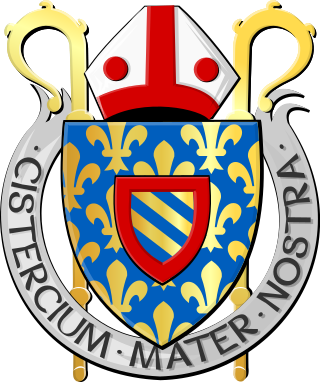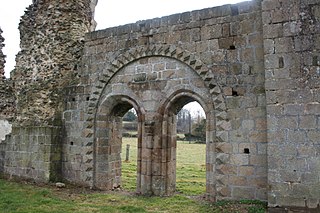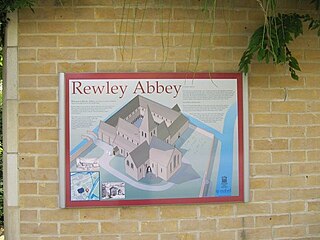Related Research Articles

Bernard of Clairvaux, O. Cist., venerated as Saint Bernard, was an abbot, mystic, co-founder of the Knights Templar, and a major leader in the reform of the Benedictines through the nascent Cistercian Order.

Clairvaux Abbey was a Cistercian monastery in Ville-sous-la-Ferté, 15 kilometres (9.3 mi) from Bar-sur-Aube. The original building, founded in 1115 by Bernard of Clairvaux, is now in ruins; the bulk of the present structure dates from 1708. Clairvaux Abbey was a good example of the general layout of a Cistercian monastery. The abbey has been listed since 1926 as a historical monument by the French Ministry of Culture.

Cîteaux Abbey is a Catholic abbey located in Saint-Nicolas-lès-Cîteaux, south of Dijon, France. It is notable for being the original house of the Order of Cistercians. Today, it belongs to the Trappists.

The Cistercians, officially the Order of Cistercians, are a Catholic religious order of monks and nuns that branched off from the Benedictines and follow the Rule of Saint Benedict, as well as the contributions of the highly-influential Bernard of Clairvaux, known as the Latin Rule. They are also known as Bernardines, after Saint Bernard himself, or as White Monks, in reference to the colour of the "cuculla" or cowl worn by the Cistercians over their habits, as opposed to the black cowl worn by Benedictines.
Sir John Lexington was a baron and royal official in 13th century England. He has been described as having been Lord Chancellor, but other scholars believe he merely held the royal seals while the office was vacant or the chancellor was abroad. He served two terms, once from 1247 to 1248, and again from 1249 to 1250.
Henry Murdac was abbot of Fountains Abbey and Archbishop of York in medieval England.

Pontigny Abbey, the church of which in recent decades has also been the cathedral of the Mission de France, otherwise the Territorial Prelature of Pontigny, was a Cistercian monastery located in Pontigny on the River Serein, in the present diocese of Sens and department of Yonne, Burgundy, France. Founded in 1114, it was the second of the four great daughter houses of Cîteaux Abbey. It was suppressed in 1791 in the French Revolution and destroyed except for the church. In 1843 it was re-founded as a community of the Fathers of St. Edmund. In 1909 it passed into private ownership. In 1941 it became the mother house of the Mission de France, a territorial prelature.

The Abbey of Fontenay is a former Cistercian abbey located in the commune of Marmagne, near Montbard, in the département of Côte-d'Or in France. It was founded by Saint Bernard of Clairvaux in 1118, and built in the Romanesque style. It is one of the oldest and most complete Cistercian abbeys in Europe, and became a UNESCO World Heritage Site in 1981. Of the original complex comprising church, dormitory, cloister, chapter house, caldarium, refectory, dovecote and forge, all remain intact except the refectory and are well maintained. The Abbey of Fontenay, along with other Cistercian abbeys, forms a connecting link between Romanesque and Gothic architecture.

Tre Fontane Abbey, or the Abbey of Saints Vincent and Anastasius, is a Roman Catholic abbey in Rome, held by monks of the Cistercian Order of the Strict Observance, better known as Trappists. It is known for raising the lambs whose wool is used to weave the pallia of new metropolitan archbishops. The pope blesses the lambs on the feast of Saint Agnes on January 21. The wool is prepared, and he gives the pallia to the new archbishops on the Solemnity of Saints Peter and Paul, the Holy Apostles.

Henry of France, bishop of Beauvais (1149–1161), then archbishop of Reims (1161–1175), was the third son of King Louis VI of France and Adelaide of Maurienne.
Peter, usually known as Peter of Tarentaise, was a Cistercian monk who served as the archbishop of Tarentaise from 1141 until his death.
Henry of Marcy, or Henry de Marsiac, was a Cistercian abbot, first of Hautecombe in Savoy (1160–1177), and then of Clairvaux, from 1177 until 1179. He was created Cardinal Bishop of Albano by Pope Alexander III at the Third Lateran Council in 1179.

Savigny Abbey was a monastery near the village of Savigny-le-Vieux (Manche), in northern France. It was founded early in the 12th century. Initially it was the central house of the Congregation of Savigny, who were Benedictines; by 1150 it was Cistercian.
Henry of Lexington was a medieval Bishop of Lincoln.

Vaux-de-Cernay Abbey is a former Cistercian monastery in northern France (Île-de-France), situated in Cernay-la-Ville, in the Diocese of Versailles, Yvelines. The abbey was abandoned during the French Revolution and fell into partial ruin. Most of the buildings, except for the church, were restored in the late 19th century by Charlotte de Rothschild, and the property is now a hotel.
Robert of Lexinton was a British judge and administrator.

The Cistercian Abbey of Rewley was an abbey in Oxford, England. It was founded in the 13th century by Edmund, 2nd Earl of Cornwall. Edmund's father, Richard, 1st Earl of Cornwall, founder of Hailes Abbey, had intended to establish a college or chantry of three secular priests to pray for his soul, but his son Edmund substituted 'six Cistercian monks, having more confidence in them'. If this was the original plan, it was soon enlarged. In 1280 he offered the general chapter of the Cistercian order to found a college (studium) for Cistercians at Oxford, and the chapter accepted the offer, and decreed that the college should have the same privileges as the college of St. Bernard at Paris, and that it should be under the Abbot of Thame, as the other was under the Abbot of Clairvaux. The following year the chapter decreed 'out of due respect to the Earl of Cornwall' that the Abbot of Thame should be empowered to appoint an Abbot of his own choice for the house of study at Oxford, and that there should be a daily memory of the late Earl of Cornwall at Mass at the college (studium) of Oxford, according as the Abbot of the place shall ordain.

Cambron Abbey was a Cistercian abbey in Cambron-Casteau, in the municipality of Brugelette, Hainaut, Belgium. It was located on the river Blanche, a tributary of the Dender, about 9 km (5.6 mi) to the south-east of Ath. Dissolved in 1782, parts of the abbey still survive as ruins within Pairi Daiza zoo and botanical garden.
Richard was an English Benedictine and Cistercian, the first abbot of Fountains.
Guy de Bourgogne, O.Cist., was a French monk, Abbot, and Cardinal of the Roman Catholic Church.
References
- 1 2 3 4 Hunt 1893.
- ↑ http://www.british-history.ac.uk/report.aspx?compid=39925 A History of the County of Shropshire, Volume 2, Eds. Gaydon, Pugh; 1973, "The Abbey of Buildwas"
- ↑ "Huit siècles d'histoire".
- ↑ The Gentleman's Magazine, June, 1841, "The Conventual College of the Bernardins at Paris", p. 592-597
- ↑ "Book of Nature". World Digital Library . 20 August 1481. Retrieved 27 August 2013.
- ↑ http://medievalsourcesbibliography.org/sources/1458413928 Medieval Sources listing
![]() This article incorporates text from a publication now in the public domain : Hunt, William (1893). "Lexinton, Stephen de". In Lee, Sidney (ed.). Dictionary of National Biography . Vol. 33. London: Smith, Elder & Co.
This article incorporates text from a publication now in the public domain : Hunt, William (1893). "Lexinton, Stephen de". In Lee, Sidney (ed.). Dictionary of National Biography . Vol. 33. London: Smith, Elder & Co.